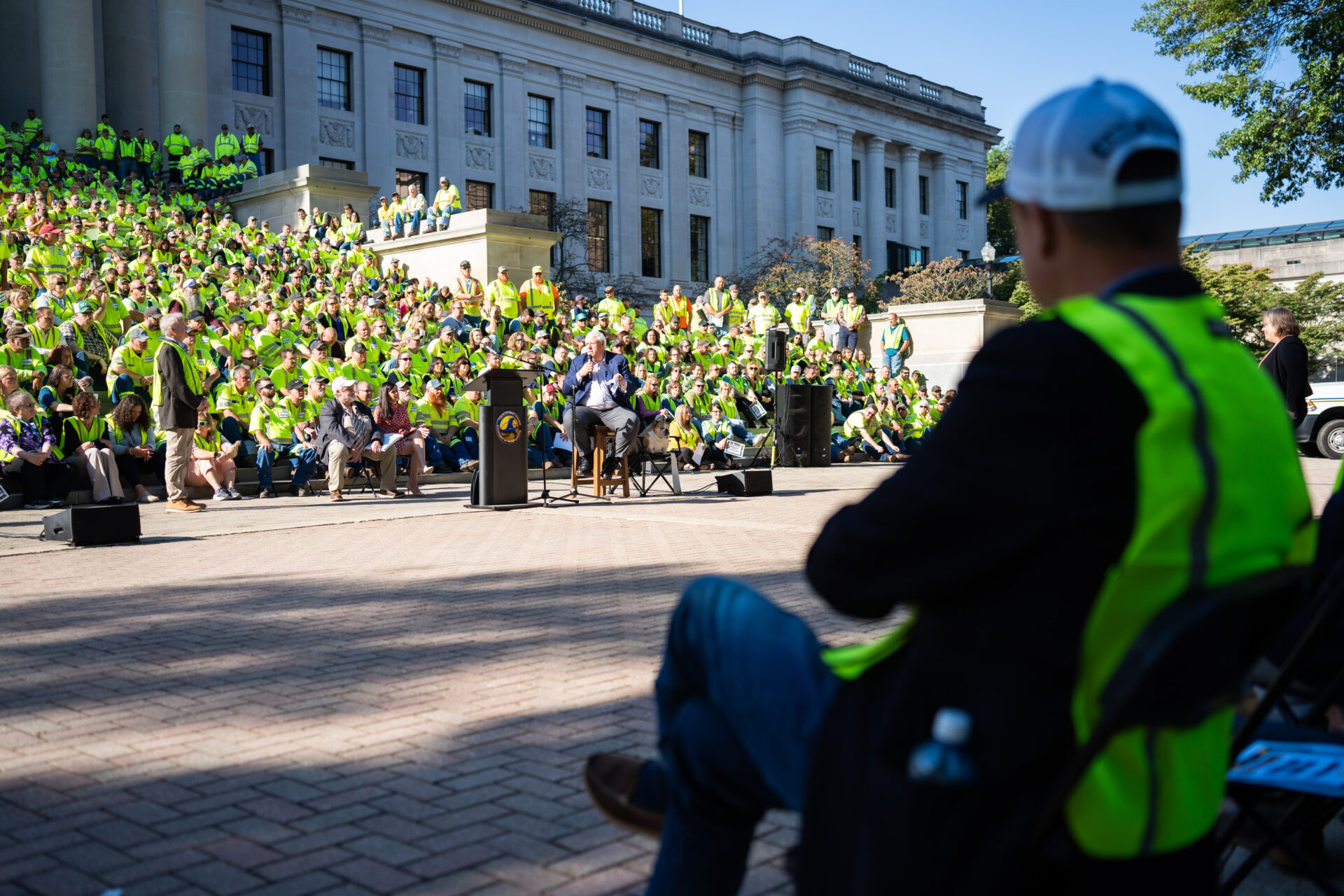To celebrate the 1,320 Roads to Prosperity projects completed, or at least begun, Gov. Jim Justice posed on the state Capitol steps with 1,320 state highway workers.
In 2017, Justice pushed for a statewide bond issue that would raise $2.8 billion. The measure passed with 73 percent support.
At the ceremony, each highway worker held up a card identifying one of the projects funded by the bond package.
“This is absolutely one of the most important days in West Virginia history. We have accomplished things that nobody believed could have ever been possible,” Justice said. “In fact, there were a lot of people that doubted this program. Despite the doubts, Toby and Edith made it known they were done being last, and they put their faith in the Roads to Prosperity program. We all believe in that vision now.”
The program included major projects like the $224 million effort to replace or upgrade 26 bridges along Interstate 70 in Wheeling and the $254 million project to expand Interstate 64 to six lanes between Nitro and the U.S. 35 exit, which also replaced the Donald M. Legg Memorial Bridge.
As part of the project to expand Interstate 64, the twin spans were built to eliminate the constriction of traffic flow and to improve driver safety. The project also called for the construction of five other new bridges.
According to a press release from the governor’s office, that project is expected to be finished by the end of October.
Two years into the Roads to Prosperity program, work began on a project to replace or rehabilitate 26 bridges in and around Interstate 70 in the Wheeling area.
This $224 million project replaces or rehabilitates infrastructure dating back more than a half-century.
Corridor H was another project funded under the Roads to Prosperity program. Located in Grant, Tucker and Hardy counties, the four-lane highway has been in progress for decades but construction stalled until additional funding was secured through the Roads to Prosperity program.
By stretching from Weston across central West Virginia to eventually connect with Interstate 81 in Strasburg, Virginia, Corridor H will connect the state’s highlands to eastern ports and reduce travel times through the mountains.
Today, more than 100 miles of Corridor H are open to traffic with approximately 30 miles of construction remaining.
The West Virginia Turnpike is a classic staple to most West Virginian’s childhood beach trips, but the section around Beckley has historically been one of the most congested portions of the entire Turnpike.
In 2021, a $140 million widening project between mile marker 40 and mile marker 48 was completed, opening six lanes for the eight-mile stretch of highway.
Another road construction project that lost funding and stalled before Roads to Prosperity revived it is the Coalfields Expressway.
Construction began in 1999 on the four-lane limited access highway designed to connect the West Virginia Turnpike at Beckley with U.S. 23 in Slate, Virginia.
Justice committed to extending the Coalfields Expressway in 2017 as part of the Roads to Prosperity program, aiming to open the southern coalfields to economic development opportunities.
In 2020, about nine miles of the expressway opened to traffic.
In May 2022, a $147.6 million project was awarded to Bizzack Construction to build a five-mile section of highway from Welch to WV Route 16 to connect the town with the Coalfields Expressway.
About 18 miles of the Coalfields Expressway are currently open to traffic.
Near Bluefield, in the southern coalfields, the development of the King Coal Highway began in the 1990s and stalled due to a lack of funding.
The first section of the King Coal Highway connects Airport Road to the previously constructed Christine Elmore West Bridge and the bridge to the intersection of John Nash Boulevard and U.S. 460. The approximately $68 million project restarted construction in 2018.
A two-mile section of the King Coal Highway connecting Airport Road to Interstate 77 and a four-mile section connecting U.S. 119 to Belo north of Williamson is currently open to traffic. About 10 miles between Red Jacket and Mountain View is also open.
Upon completion, the King Coal Highway will be a four-lane highway approximately 95 miles long, running through McDowell, Mercer, Mingo, Wyoming and Wayne counties.
Roads to Prosperity also funded smaller bridge, paving and slide repair projects in every county — many of which might have remained untouched for years without this initiative.
